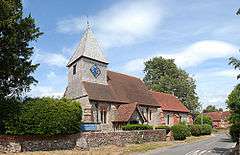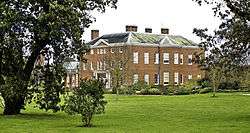East Clandon
| East Clandon | |
 East Clandon has this church dedicated to St Thomas a Becket mostly dating to the 12th and 13th centuries |
|
 Hatchlands Park (National Trust) is among the largest homes and estates in the county. |
|
 East Clandon |
|
| Area | 5.86 km2 (2.26 sq mi) |
|---|---|
| Population | 268 (Civil Parish)[1] |
| – density | 46/km2 (120/sq mi) |
| OS grid reference | TQ059515 |
| District | Guildford |
| Shire county | Surrey |
| Region | South East |
| Country | England |
| Sovereign state | United Kingdom |
| Post town | Guildford |
| Postcode district | GU4 |
| Dialling code | 01483 |
| Police | Surrey |
| Fire | Surrey |
| Ambulance | South East Coast |
| EU Parliament | South East England |
Coordinates: 51°15′11″N 0°29′01″W / 51.253°N 0.4836°W
East Clandon is a village and civil parish in Surrey, England on the A246 between the towns of Guildford to the west and Leatherhead to the east. Neighbouring villages include West Clandon and West Horsley.
In 2011 it had a population of 268 in 109 households clustered around three buildings, the church of St Thomas of Canterbury, The Queen's Head pub and the village hall. Centred 4 miles (6 km) east of Guildford, the parish landscape includes a large farm and Hatchlands Park, a similar but National Trust estate and including a great mansion, which replaced the manor house. There are arable and livestock farmland and woodlands along the North Downs and a golf course in East Clandon.
History
Early history
The word Clandon (first recorded as Clanedune) goes back to Anglo-Saxon times, meaning "clean down" (open downland) from the North Downs hills that rise to the south of the village. People settled here due to the availability of water that emerged where the high chalk downs meet the lower lying clay to the north.
Chertsey Abbey, a Benedictine foundation, was patron of East Clandon from the Norman Conquest of 1066 to the Dissolution of the Monasteries in 1539. East Clandon appears in Domesday Book as Clanedun. It was held by Chertsey Abbey. Its assets were then: 4 hides; 7 ploughs, woodland for 6 hogs. It rendered £6 per year to its overlords.[2] In ancient documents the village is also often referred to as Clandon Abbatis (Abbot's Clandon). The church was built in the 12th and 13th centuries and is a Grade I listed building (the highest category). The main addition to it has been a bell tower added in 1900.[3]
In 1544 Henry VIII granted East Clandon Manor to Sir Anthony Browne. The manor house, thought to have been close to where Hatchlands Park now is, was moated since times of unrest in the early 14th century. The house, and with it the village, changed hands many times during the next 200 years.
The oldest houses in the village, Frogmore Cottage, Lamp Cottage, Old Manor Farm, Tunmore Cottage among others, had already been built when the London brewer John Raymond sold the Hatchlands Park estate to Admiral Boscawen in 1749. The present Hatchlands House was built for him with the help of prize money from his victory over the French, and it was completed in 1758, only three years before the Admiral died.
1761 to present
From 1768 the Sumner family owned the Hatchlands estate until it was bought at auction in 1888 by Lord Rendel. In 1913 his eldest daughter's son Captain Harry Stuart Goodhart-Rendel inherited the estate in trust. The captain was a professional architect and took a great interest in the village and its inhabitants. According to the writings of Maurice Wiggin, Goodhart-Rendel was a tall, spare, upright figure making his daily round in the village dressed in his grey tweed suit and soft brown trilby shouting to his dogs in a real Grenadier's voice. Every Christmas this 'squire' gave a children's tea party at Hatchlands, complete with Christmas tree and gifts for all comers. Christmas carol concerts are still held at Hatchlands for villagers today.
Several houses in the village were built to his drawings, including Antler's Corner, Appletree Cottage, Meadow Cottage and 5 School Lane (1910), Prospect Cottages (1914), Snelgate Cottages (1926) and the St Thomas' Housing Society Cottages (1947).
In 1945 the Hatchlands house, park and some land were given to the National Trust. When Captain Goodhart-Rendel died in 1959 the estate passed into the hands of two relatives, a split he regarded with misgivings. Late 20th century owners, the Dunne-Ritche estate, sold most houses around 1970, but a few still remain in their possession.
The TV series Catweazle was shot in East Clandon (on Home Farm), West Horsley and the surrounding area in summer 1969. Home Farm still hosts the annual Hexwood Summer Fete.
Notable residents of East Clandon
Sir Anthony Browne 1500-1548. Standard bearer of England. Owner of Manor of East Clandon.
Thomas Goffe 1591-1629. A minor Jacobean playwright. Rector of East Clandon
Admiral Edward Boscawen. 1711-1761. Builder of Hatchlands Park.
Stuart, Baron Rendel 1834-1913. Founder of University College of Wales, Aberystwyth and owner of Hatchlands Park.
Harry Stuart Goodhart-Rendel. 1887-1959. Architect and Slade Professor of Fine Art at Oxford University. President of the Royal Institute of British Architects. Owner of Hatchlands Park.
Francis Octavius Grenfell VC. Recipient of the first Victoria Cross of the First World War; born at Hatchlands Park.
Sir Freddie Laker. 1922-2006. Airline pioneer. Lived at New Manor Farm.
Demography and housing
| Output area | Detached | Semi-detached | Terraced | Flats and apartments | Caravans/temporary/mobile homes | shared between households |
|---|---|---|---|---|---|---|
| (Civil Parish) | 47 | 49 | 11 | 2 | 0 | 0 |
The average proportion of accommodation in the region composed of detached houses was 28%, the average that was apartments was 22.6%.
| Output area | Population | Households | % Owned outright | % Owned with a loan | hectares[1] |
|---|---|---|---|---|---|
| (Civil Parish) | 268 | 109 | 46.8% | 27.5% | 586[1] |
The proportion of households in the civil parish who owned their home outright compares to the regional average of 35.1%. The proportion who owned their home with a loan compares to the regional average of 32.5%. The remainder is made up of rented dwellings (plus a negligible % of households living rent-free).
See also
References
- 1 2 3 4 Key Statistics; Quick Statistics: Population Density United Kingdom Census 2011 Office for National Statistics Retrieved 21 November 2013
- ↑ Surrey Domesday Book Archived October 30, 2007, at the Wayback Machine.
- ↑ Historic England. "Details from listed building database (1029446)". National Heritage List for England.
Further reading
- Maurice Wiggin (1972) Faces at the Window. London: Nelson ISBN 0-17-142013-6
External links
| Wikimedia Commons has media related to East Clandon. |
